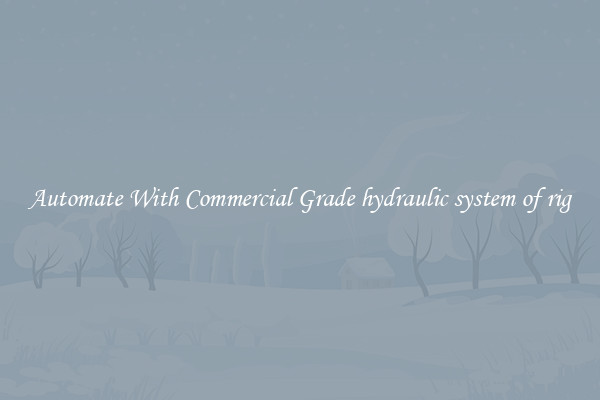Automate With Commercial Grade hydraulic system of rig
Hydraulic systems are an integral part of many industrial machines and equipment. They play a crucial role in providing power and control to these systems, ensuring their efficient operation. Commercial grade hydraulic systems are specifically designed for heavy-duty applications, such as those found in rigs used in the oil and gas industry.

One of the key benefits of using a commercial-grade hydraulic system in a rig is its reliability and durability. These systems are built to withstand the harsh conditions and heavy loads that are common in the rig environment. They are designed to operate continuously for long periods of time without breakdowns or maintenance issues, ensuring that the rig can perform its tasks without interruption.
Another advantage of using a commercial-grade hydraulic system is its efficiency. These systems are designed to deliver maximum power and performance with minimal energy consumption. This not only helps to reduce operating costs but also minimizes the environmental impact of the rig operation. By automating the hydraulic system, operators can further optimize its performance and ensure that it operates at peak efficiency at all times.
Automation also improves the safety of rig operations. By automating the hydraulic system, operators can minimize the risk of accidents and injuries that can occur when manually controlling hydraulic equipment. Automated systems can be programmed to perform tasks with precision and consistency, reducing the chance of human error and ensuring that the rig operates safely and effectively.
Furthermore, automation can also improve the overall productivity of the rig. By automating the hydraulic system, operators can streamline the rig operation and increase the efficiency of its tasks. This can lead to faster completion of projects and higher output, ultimately leading to increased profitability for the rig owner.
In conclusion, utilizing a commercial-grade hydraulic system in a rig can offer numerous benefits, including improved reliability, efficiency, safety, and productivity. By automating these systems, operators can further optimize their performance and ensure that the rig operates at its highest level of efficiency. This can ultimately lead to cost savings, increased profitability, and a safer working environment for all rig personnel.

View details

View details

View details

View details








